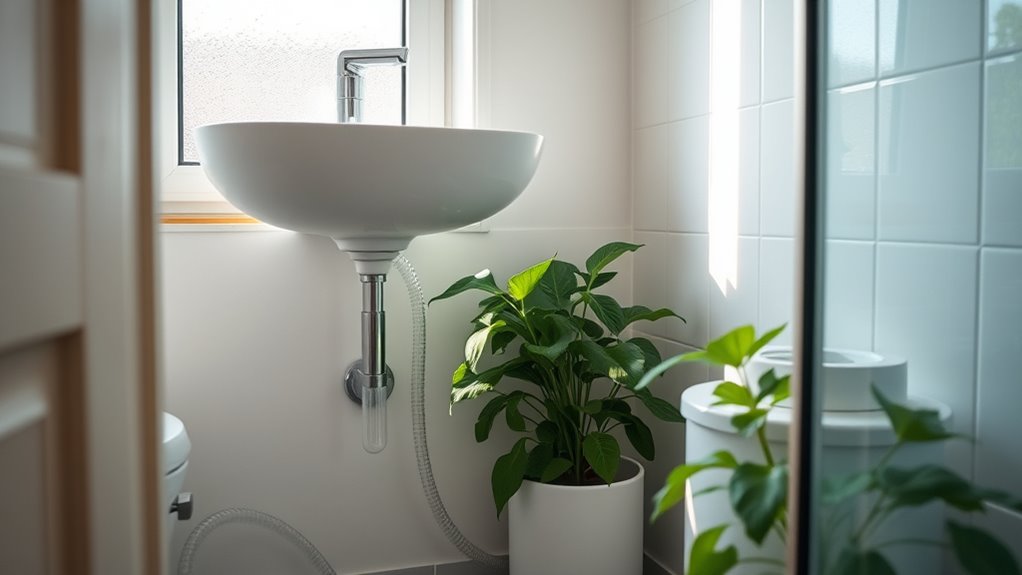Greywater is household wastewater from sources like sinks, showers, or laundry that’s relatively safe to reuse outdoors for watering plants or gardens. As a renter, you can set up simple systems using hoses or gravity-fed pipes without major plumbing changes. Make sure to avoid harsh chemicals and switch back to regular drainage when needed. Want to learn easy, safe ways to get started with greywater? Keep exploring for practical tips and guidelines.
Key Takeaways
- Greywater is household wastewater from sinks, showers, and laundry, safe for outdoor reuse with proper management.
- DIY greywater systems are renter-friendly, requiring minimal plumbing changes and easy installation or removal.
- Use biodegradable soaps and avoid harmful chemicals to ensure safe greywater reuse and protect plants and the environment.
- Regularly inspect and maintain the system to prevent leaks, clogs, and property damage, following local regulations.
- Check local laws before installing a greywater system, and design it to be temporary and easily removable.

Ever wondered how you can reduce water waste even as a renter? One effective way is by exploring DIY greywater systems, which allow you to reuse water from sinks, showers, and washing machines for garden irrigation. As a renter, you might think you’re limited in how you can conserve water, but small, manageable projects like setting up a DIY greywater system can make a significant difference. These systems help you divert water that would otherwise go down the drain and reuse it to keep your plants healthy, reducing your water bill and environmental impact.
To start, understand that greywater is any relatively clean wastewater generated from household activities. It’s different from wastewater containing sewage, making it safer to reuse for outdoor purposes like garden irrigation. As a renter, you don’t need extensive plumbing modifications—many DIY greywater systems are simple to install and can be designed to suit your apartment balcony or small yard. For example, you can set up a basic system using hoses or pipes that direct greywater from your washing machine or bathroom sink directly into your garden beds. This way, you’re watering your plants with minimal effort and without risking your security deposit.
Greywater systems are simple to install and perfect for renters with small outdoor spaces.
Creating your own greywater system doesn’t require professional skills, but it does demand some planning. First, identify the sources of greywater you’re comfortable redirecting—such as the laundry or bathroom sink. Make sure to avoid water contaminated with harmful chemicals or substances, like bleaches or harsh cleaning agents, as they can harm your plants. Use biodegradable soaps and cleaners to keep the greywater safe for your garden. Next, set up a simple collection and distribution system—using hoses or gravity-fed pipes—that channels greywater directly to your plants. You might want to install a diverter valve, which allows you to switch between normal drainage and greywater reuse, giving you control over when you’re recycling water.
This approach is especially handy for outdoor garden irrigation. Instead of wasting water, you’re providing your plants with nutrient-rich moisture, which encourages healthy growth. Plus, it’s a sustainable practice that aligns with eco-friendly living. Keep in mind, while DIY greywater systems are practical, you should always check local regulations about greywater reuse to avoid any legal issues. Also, regularly inspect your system for leaks or clogs to ensure it functions properly and doesn’t cause any damage to your property.
Frequently Asked Questions
Can Renters Legally Install Greywater Systems Without Landlord Approval?
You generally can’t legally install greywater systems without your landlord’s approval, especially with DIY plumbing, which might violate lease terms or local regulations. It’s essential to get permission first, as unauthorized modifications could lead to penalties or eviction. Focus on water-saving habits instead—like shorter showers—to reduce water use. Always check local laws and your lease agreement before attempting any greywater projects, ensuring you stay compliant and avoid trouble.
What Are the Costs Associated With Greywater System Installation for Renters?
Installation costs for a greywater system can range from a few hundred to several thousand dollars, depending on system complexity and your home’s setup. You’ll also face ongoing maintenance expenses, such as filter replacements and system checks, which could add to your budget over time. As a renter, you should consider these costs carefully and discuss them with your landlord before proceeding, as they impact your overall expenses and system longevity.
How Do Greywater Systems Affect Renters’ Security Deposits?
Did you know that only 30% of landlords approve greywater systems? Installing one may impact your security deposit, as landlords often see it as a modification requiring approval. Always get your landlord’s consent before making any changes. If approved, make certain you follow proper guidelines to avoid damage that could lead to deductions from your security deposit. Clear communication helps protect your deposit and maintains a good rental relationship.
Are There Specific Greywater Restrictions in Rental Properties?
Yes, there are specific greywater regulations and rental property restrictions you need to abide by. Local laws often specify how you can use greywater, especially in rental homes, to prevent health and safety issues. Before installing a greywater system, check with your landlord and local authorities to ensure compliance. Ignoring these restrictions could lead to fines or damage to your security deposit, so always stay informed about greywater regulations in your area.
Can Greywater Systems Be Easily Removed When Moving Out?
Yes, greywater systems can be removed when you move out. The removal process usually involves disconnecting pipes and ensuring system compatibility with your new property. You should document the installation to make reinstallation easier later. Keep in mind, some systems are designed to be easily portable, while others may require professional assistance. Always check with your landlord or local regulations before removal to avoid potential issues.
Conclusion
Thinking about greywater might seem overwhelming at first, but it’s like planting a seed—you start small, and with care, it grows into something sustainable. When I first tried recycling greywater, I felt like I was giving my apartment a little eco-friendly hug. Just like a small plant can flourish with the right attention, your efforts can make a big difference for the environment—and your wallet. Every step counts toward a greener, more responsible living space.









